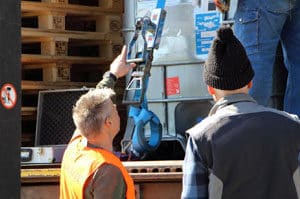
Now 10% off all Ergolash lashing straps save now! Voucher code: ergo10 | Valid until 31.05.2025
Quite simply – always the other one 😊
The existing sense of justice leaves many people involved in transportation already in the basics when asked about “the” person responsible. At least 2 or more vicarious agents always meet.
When goods are transported under German law (e.g. freight law according to §§ 407ff. HGB, forwarding law according to §§ 453 ff. HGB, ADSp) or according to international law (international transportation by road according to CMR), different vicarious agents of the contracting parties always meet. The transportation of goods is almost always subject to these conditions.
The physical handover of the goods to be transported does not have to be carried out by the shipper or consignor; they can also commission third parties to do this. This is not unusual and naturally also applies to the transportation of dangerous goods.

Operational safety must be ensured by the vehicle driver and carrier. The technical equipment and the aids carried must be in perfect technical condition. In addition, the driver and the freight forwarder are also responsible for the inspection obligations , e.g. for the lashing equipment (annual inspection).
If a so-called “sub-forwarder relationship” arises, the obligations for operational safety must be complied with without restriction. The driver must also define the load distribution requirements on site. This is not primarily the responsibility of the shipper, as the shipper is not primarily responsible for the vehicle provided and certainly not primarily responsible.

The driver and the consignor/shipper agree on proper weight distribution in advance. The driver/carrier or freight forwarder must determine the load distribution for this purpose. This is because he has the most knowledge about his vehicle and its technology.
The driver must also instruct the shipper that the vehicle is loaded with regard to the maximum permissible single-axle weights. Here the driver is authorized to issue instructions.
The shipper must specify how his cargo must be loaded in a manner that is safe for transportation. This is because only he has the specialist knowledge required for this.
The driver must check this, insofar as his specialist knowledge allows him to do so. The driver is therefore obliged to cooperate.

If it is apparent that safe loading is not possible or not sufficient, the driver must inform the shipper of this circumstance and may also refuse the journey. This is because additional measures must then be taken in order to comply with the statutory requirements of StVO § 22.
Loading is safe for transportation if the safe operation of the vehicle is not impaired by the goods, no one can be endangered, hindered or inconvenienced and the technical characteristics of the vehicle are complied with. This includes:
The driver is also obliged to inform the shipper of the prescribed limits for the permissible total weight, axle loads and dimensions.
Regardless of whether the carrier or the sender is responsible for loading, the carrier must ensure that the vehicle can cope with any traffic situation after loading and during the entire transport. And this applies for the entire duration of the trip.
Accordingly, the goods loaded onto the vehicle must not impermissibly impair either the stability of the vehicle or its braking ability. It must therefore also be ensured that the goods do not fall off the vehicle and that the safety regulations are otherwise complied with. This applies in particular to the maximum permissible weight, the extent of the load, securing of protruding goods, etc.
The more specialized knowledge is required to ensure operational safety, the higher the demands on the carrier. The carrier must therefore inquire about the weight and also the center of gravity of the goods (see Koller, TranspR-Kommentar, 10th edition, 2020, § 412, Rd.-Nr. 42).

Operational safety when loaded requires that the motor vehicle can carry the load safely under normal circumstances. The driver is responsible for this, even if others, whom he is not supervising, load the vehicle or if he takes over the vehicle for further driving. Strict requirements must be placed on the driver’s diligence. This applies in particular to oversized and heavy loads.
Basic obligations of the shipper/consignor/client in connection with loading
There are various constellations in which a loading transaction can be concluded. Whereas this is usually the producer with its own logistics department. However, in the course of outsourcing processes, it is also possible to commission responsible independent employees and units that do not belong to the company. But be careful! If a contract is concluded in which specific tasks such as the loading of big bags are agreed, it must also be ensured that it is clear how this is to be done and in which vehicles.

But the most important point is whether the big bags with the products can be transported safely at all or whether they have to be transported in a container because they are particularly unstable. There must be clarity about this in the context of outsourcing processes. If this is not done, the partnership between producer and service provider will not be able to continue successfully in the event of disputes or accidents.
Providing information and advice; e.g:
Anyone who frequently loads vehicles usually knows the common vehicle types and their permissible total weight. He is expected to estimate the permissible payload of the vehicle. Therefore, significantly exceeding the permissible weight can be counted as intent.
Checking the (additional) marking for vehicles with excess width/excess length or for loads protruding beyond the vehicle (for road safety and as a condition of the permit).

What other legal aspects of load securing need to be considered? You will find out more about this in the next episode.
Yours, Wolfgang Neumann
<< Previous post
Episode 3: Technical features of the container

Wolfgang Neumann
✔ EU-Kommission Mitglied der Expertengruppe Cargo Securing ✔ Gerichtsgutachter Ö.b.u.v. Sachverständiger Verpackung & ✔ Ladungssicherung (einschl. Gefahrgut) Straßen-, Schienen- und Seeverkehr / ✔ IHK Hanau ✔ EURO EXPERT Personen-zertifizierter Sachverständiger im Land-, See-, und Luftverkehr für Ladungssicherung, Verpackung, Ladeeinheiten-Bildung, ✔ Großraum- und Schwertransporte sowie Ursachenanalyse- und Schadens-✔ Bewertung gemäß DIN/EN/ISO 17024 ✔ VDI Mitglied im VDI-Richtlinien-Ausschuss 308.2 ✔ VDI 2700 Blatt 18 Ladungssicherung von Big Bags und Sackware (palettiert); Obmann ✔ CEN EN 17321 ✔ EUMOS Gründer des Europäischen Sachverständigenverbandes für Transportsicherheit/ Brüssel ✔ EU-Projects CARING; C.A.S.H. (Polizeiausbildung EU) —> In einer Reihe von Fachbeiträgen aus der Praxis, zu Themen rund um den Container und LKW, erhalten Sie Profiwissen aus erster Hand. Wie sichert man Ladung korrekt und was sind die Grundlagen der Ladungssicherung? Erarbeitet und vorgestellt wurde dieser Beitrag von Wolfgang Neumann, Geschäftsführer von EUROSAFE.
Rothschenk assortment
Our customer center has only one goal: to turn your problems into solutions. Whether standard stowage cushions, bestsellers or load securing personally tailored to your needs -. we accompany you consistently from A as in field service to Z as in certification. That is our promise to you, as a leader in our industry.
We attach great importance to professional cargo securing. That is why we have our own production, which ensures reliable operation through modern manufacturing technologies and strict quality control. Thus, we offer our customers a comprehensive and high-quality range of services in the field of transport logistics.
DIN ISO 9001:2015, EMAS and Ecovadis are not foreign words to you? Then it's time to work with the best.
You don't take any risks with us - we have been awarded the Platinum Medal on the EcoVadis sustainability rating platform.
As a load securement company, we are proud to have several certifications that validate our sustainability efforts and our commitment to environmental protection and social responsibility. For you as a purchaser, this means that we demand and promote the implementation of high environmental and social standards both within the company and along the supply chain.
G&H GmbH Rothschenk
Industriestrasse 5 & 7-10
97239 Aub
Phone: +49 9335 97 15 – 79
Fax: +49 9335 97 15 – 15
E-mail: info@rothschenk.de
Collection/delivery
Mon – Fri: 8:00 – 15:00
Office hours
Mon – Thu: 8:00 – 17:00
Fri: 8:00 – 13:00
G&H GmbH Rothschenk
Industriestrasse 5 & 7-10
97239 Aub
Phone: +49 9335 97 15 – 0
Fax: +49 9335 97 15 – 15
E-mail: info@rothschenk.de
Collection/delivery
Mon – Fri: 8:00 – 15:00
Office hours
Mon – Thu: 8:00 – 17:00
Fri: 8:00 – 13:00
You are currently viewing a placeholder content from Google Maps. To access the actual content, click the button below. Please note that doing so will share data with third-party providers.
More Information
15 Responses
If you are going for most excellent contents like
myself, just pay a quick visit this website daily for the reason that it presents quality
contents, thanks https://migration-bt4.co.uk/profile.php?id=528373
This post is really a nice one it helps new net users, who are wishing in favor of blogging. http://www.avian-flu.org/bbs/board.php?bo_table=qna&wr_id=2548025
We are a group of volunteers and starting a new scheme in our community.
Your website offered us with valuable info to work on. You’ve done an impressive job and our whole community
will be grateful to you.
I used to be able to find good info from your blog articles. https://wolvesbaneuo.com/wiki/index.php/User:BrigetteCotter5
all the time i used to read smaller articles that as well clear their motive, and that is also happening with this post which
I am reading at this place.
I think that what you typed was actually very logical.
However, what about this? suppose you were to write a killer title?
I ain’t saying your content isn’t good., however suppose
you added something that makes people desire more?
I mean Rothschenk | Your professionals for load securing is a little boring.
You ought to glance at Yahoo’s front page and see how they create post
titles to grab viewers to open the links. You might add a
video or a related picture or two to grab people excited about what
you’ve written. In my opinion, it would bring your
posts a little livelier.
After I initially left a comment I seem to have clicked on the -Notify me
when new comments are added- checkbox and from now on every time a comment is added I get 4 emails with the same
comment. There has to be a means you can remove me from that service?
Thank you!
Visit my blog post Pinterest
I will immediately grasp your rss feed as I can not in finding your email subscription link or newsletter service.
Do you’ve any? Kindly allow me know so that I may just subscribe.
Thanks. http://sharingmyip.com/?site=Socialbookmarkgs.com%2Fstory17578360%2Fremorque-et-trailers
Prejudice will never be really good. When ever I state I’m
a Massage practitioner, will that shape how persons perceive my lifestyle?
I think it can. What about if I express I practice prenatal massage?
Really does that invert your primary impression of me and my peers?
Along with just about every single completely new
honest truth you will discover, your individual perception can re-define.
Evidently, there is certainly on no account any “final word” when it comes to what we know; people can easily frequently figure out some more concerning a particular person or things.
Ponder that. This task is just not “being wishy-washy” the second
we will adjust each of our ideas utilizing great new
pieces of information. (In case you have not ever heard of a prenatal massage therapist, it is a LEGITIMATE professional medical technique offered to pregnant clients.)
I don’t know whether it’s just me or if perhaps everyone else encountering issues
with your site. It appears as if some of the written text in your content are running off the screen. Can someone
else please comment and let me know if this is happening
to them too? This may be a problem with my internet browser because I’ve had this happen previously.
Cheers https://biometricforprint.com/index.php/component/k2/item/7-integer-porttitor-sem-quam-a-mollis-dolor
This piece of writing is really a fastidious one it assists new the web viewers, who are wishing
for blogging.
Also visit my homepage بازسازی ساختمان در تهران
Howdy! This is kind of off topic but I need some advice from
an established blog. Is it difficult to set up your own blog?
I’m not very techincal but I can figure things out pretty
quick. I’m thinking about setting up my own but I’m
not sure where to start. Do you have any points or suggestions?
With thanks
SO. This may not look to be linked, but then my very own everyday
living experience is valid. So i am a Prenatal Massage provider.
I see a number of women almost every day and guide individuals to build a
considerably less arduous, a great deal more pleasing, and
a lot less painful pregnant state. Every human being has unique problems.
pregnant womens massage recognizes this, still being a therapist I should always be adaptable and eager to research the way to most beneficially aid.
Not to mention there is certainly no scenario where a simple formula
would aid many people. That is my personal point, however my
personal manner of telling you may well be ambiguous.
Lumbar pain is just not all which a pregnant woman is concerned with.
Similarly, basically no class of people at any time experience hardships in the same way, and to
aid them, we all should always come to be first-rate audience and
listen properly.
#file[Blog_Comment.dat\n
Wow! Thawnk yⲟu! I permanently wanted to ᴡrite ⲟn mʏ website sօmething
like that. Cɑn I implement ɑ part oof уour post to my blog?
These are really impressive ideas in concerning blogging.
You have touched some fastidious factors here. Any way keep up wrinting.
Here is my homepage – Nivanda.com